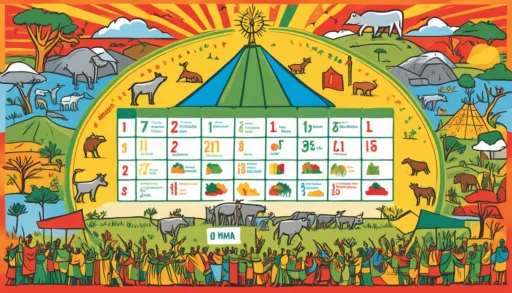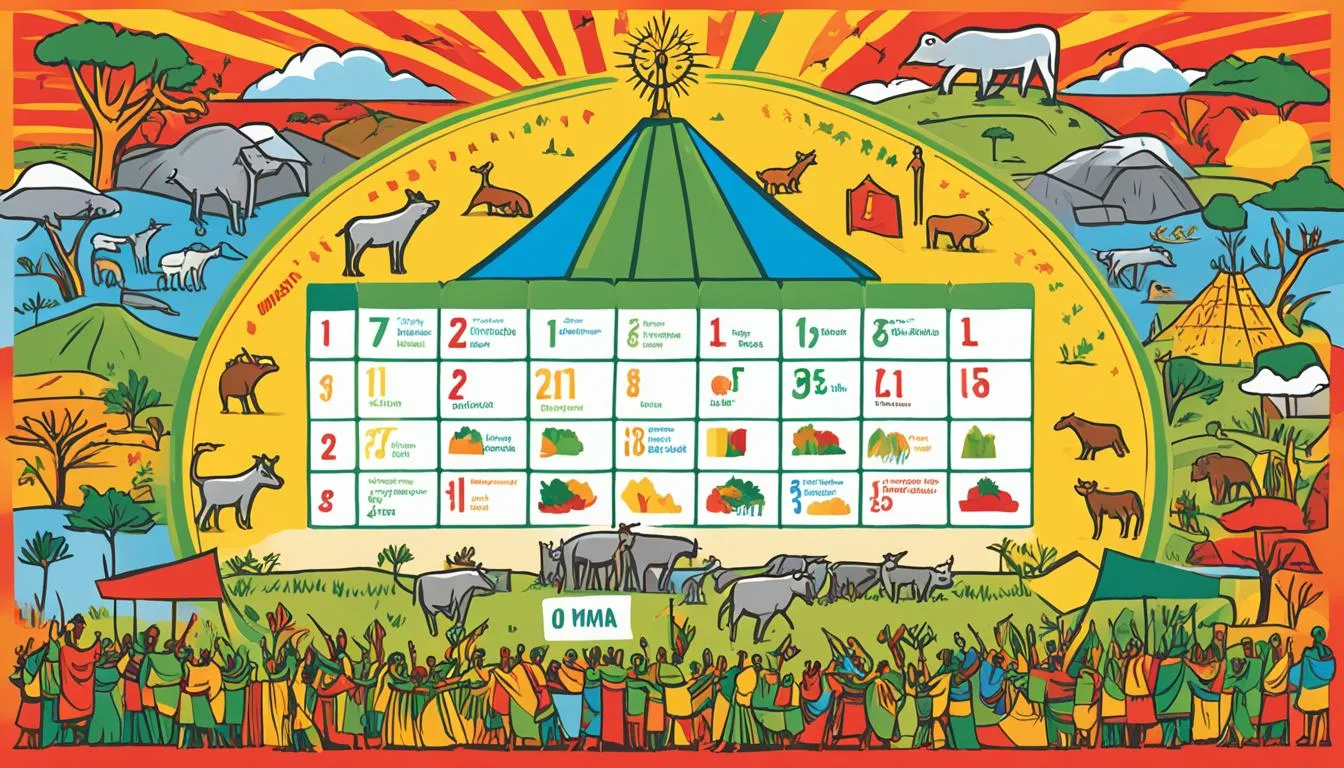When pondering the Best Time to Visit Ethiopia, the typical advice points towards the popular October to March window. But is that the whole story? In a land where ancient festivals ignite the cities and the rain paints the landscapes with emerald hues, could there be hidden gems in the lesser-known months? Ethiopia’s travel season offers a kaleidoscope of experiences, but pinpointing that sweet spot for your journey requires insider knowledge on both climate intricacies and tourist attractions in Ethiopia. Let’s dive into the vibrant tapestry of Ethiopian tourism and unravel the secrets to planning your unforgettable Ethiopian soiree.
Key Takeaways
- Optimal travel to Ethiopia is often between October and March but exploring off-peak months can unveil unique experiences.
- High altitudes in Ethiopia afford year-round moderate temperatures, a pleasant surprise for many travelers.
- Festive seasons, particularly January, see a surge in activity and rates, rewarding early planners.
- Booking in advance is crucial during the December to February peak travel season in Ethiopia.
- Post-rainy season months offer abundant natural beauty, with landscapes and waterfalls at full splendor.
Understanding Ethiopia’s Climate Variations
Embarking on an Ethiopian adventure means stepping into a world where climate plays a pivotal role in planning your travel itinerary. A fascinating aspect of Ethiopia tourism lies in its climatic diversity, largely influenced by the varying altitudes across the country. Understanding the Weather in Ethiopia not only aids in crafting an enjoyable trip but also opens the gateway to appreciating the nation’s unique environmental tapestry.
Highlands vs. Lowlands: A Tale of Two Climates
In Ethiopia, the climatic conditions differ profoundly between the highlands and lowlands. The highlands, housing bustling hubs like Addis Ababa, bask in a cooler ambiance, whereas the lowlands, such as the notorious Danakil Depression, grapple with scorching temperatures. Recognizing these are crucial for anyone interested in the intricate Climate in Ethiopia and looking for the best months to visit Ethiopia.
Mild Temperatures and Rainfall Patterns
Apart from its varying altitudinal zones, Ethiopia’s climate remains milder compared to its East African neighbors, offering a refreshing surprise to visitors. The temperate weather, with daytime temperatures hovering around 20°C-25°C throughout the year, remains one of the significant highlights of Ethiopia’s weather patterns, making it a year-round destination.
Ethiopia’s Single Rainy Season Explained
Distinct from other regions in East Africa that encounter multiple rainy spells, Ethiopia undergoes a single primary rainy season, stretching from June to early September. This season dictates travel logistics, especially for trekkers exploring the sublime highlands, and marks a transformation in the travel scene. The rainfall initiates a metamorphosis across Ethiopia’s landscapes, providing insight into why the country’s Weather in Ethiopia is a cornerstone for its Ethiopia travel season.
The table below illustrates the stark contrast between Ethiopia’s highland and lowland regions, highlighting the optimal travel periods based on weather conditions:
| Region | Altitude | Average Temperature | Best Travel Period |
|---|---|---|---|
| Addis Ababa (Highlands) | 2,355m | 20°C – 25°C | October – May |
| Danakil Depression (Lowlands) | -125m | 34°C – 41°C | November – March |
| Omo Valley (Lowlands) | 400m – 800m | 27°C – 30°C | June – September |
Whether you’re aiming to trek the immense Simien Mountains or dive into the cultural richness of the Omo Valley, grasping the climate in Ethiopia is indispensable for an immersive travel experience. While the highlands promise mild climates year-round, lowland areas demand more strategic planning, emphasizing why knowledge about the Weather in Ethiopia is crucial for any traveler.
When planning your Ethiopian tourism adventure, bearing in mind the country’s climate variability is essential. Choosing the best months to visit Ethiopia can translate to unforgettable memories, as the landscapes and cultural activities are inextricably linked to the Ethiopia travel season. Whether basking in the mild highlands or braving the intense heat of the lowlands, Ethiopia welcomes intrepid souls with a climate as diverse as its heritage.
Best Time to Visit Ethiopia

Discerning the best months to visit Ethiopia is crucial for travelers seeking the quintessential experience in this culturally rich and geographically diverse country. With a timeline stretching from October to May, the Ethiopia travel season presents warm and sunny weather ideal for indulging in the plethora of outdoor activities that Ethiopia has to offer, from breathtaking hikes in the Simien Mountains to wildlife viewing in the national parks.
While the dry season is the peak for Ethiopian tourism and offers an unobstructed opportunity to explore Ethiopia’s historical sites, it also coincides with crowded tourist hotspots and escalated costs. To avoid bustle and seek cost-effectiveness, budget-conscious adventurers may target the rainy season. Not only does this period offer reduced rates, but it also posits intermittent rain showers that still allow for substantial exploration, particularly as the wet season wanes in September.
| Month | Weather Conditions | Peak/Budget Travel Season | Activities & Benefits |
|---|---|---|---|
| October – May | Warm and sunny | Peak season | Outdoor exploration, hiking, wildlife viewing, optimal for historical sites |
| June – September | Varying rain; end of season more dry | Budget season | Economical, less crowded, lush landscapes, flowering biodiversity |
Travelers must weigh the contrasts of visiting during peaking or off-peak months, keeping in mind event schedules or personal preferences for serenity or sociability. Ethiopia, with its multifaceted environments and calendars, provides a spectrum of experiences adaptable to various travel styles and objectives. Understanding when to embark upon the Ethiopian voyage sets the stage for a memorable expedition through this ancient land’s present-day vibrancy.
Navigating Ethiopia’s Diverse Regions: When to Visit Where
Ethiopia, a country with remarkable diversity in both its culture and climate, presents travelers with a wide variety of regional climates, each recommending their own best months to visit. Whether you are drawn to the historical tourist attractions in Ethiopia or the vibrant landscapes that shape Ethiopia tourism, knowing the optimal time to explore each area can significantly enhance your travel experience.
Navigating through Ethiopia’s geographical variety requires an understanding of the unique seasonal climates that each region offers. Below, you’ll find tailored advice to help you plan your adventure according to the specific charms of each destination at just the right time.
| Region | Ideal Visit Timeline | Weather Considerations | Highlights |
|---|---|---|---|
| Northern Circuit | October to March | Dry season, cool & pleasant | Ancient churches, historic ruins |
| Rift Valley & Bale Mountains | October to May | Less rainfall, good for hiking | Stunning landscapes, wildlife viewing |
| Omo Valley | June to September & November to February | Avoid heavy rains of March to May | Cultural experiences, unique tribes |
| Danakil Depression | November to March | Extremely hot, avoid June to September | Volcanic landscapes, salt flats |
For instance, the northern parts of Ethiopia, known for their ancient historical heritage, are most accessible and enjoyable from October to March. Home to some of the paramount tourist attractions in Ethiopia, such as the rock-hewn churches of Lalibela, this period avoids the daunting rains and offers clear skies for your explorations. On the other hand, regions like the Bale Mountains are lush and teeming with life post-rainy season, making the drier months of October to May ideal for encounters with Ethiopia’s unique wildlife.
- The Omo Valley, with its rich cultural tapestry, is at its peak outside the March to May period when heavy rains can impede travel. June to September, after the rains, showcase the valley in its most vibrant form.
- The Danakil Depression offers otherworldly landscapes that are best explored in the cooler months of November to March to escape the excessive summer heat.
Aligning your travel plans with these seasonal insights ensures an immersive and comfortable journey through Ethiopia’s remarkable terrains. Indeed, those seeking the quintessential Ethiopian experience will find that each region has its own alluring time frame, making Ethiopia tourism a year-round adventure.
Special Events and Seasonal Travel Tips for Ethiopia
Ethiopian tourism peaks with vibrant cultural displays, harmonizing with the mild weather in Ethiopia to make it a premier destination for travelers seeking both adventure and culture. When planning your Ethiopia travel season, consider aligning your trip with the country’s rich tapestry of festivals and natural events. Discover when to witness Ethiopia’s natural landmarks in their full glory and anticipate the ebb and flow of visitor traffic throughout the year.
Festivals Worth Scheduling Your Trip Around
Ethiopian festivals are some of the most colorful and energetic celebrations found anywhere in the world. The dry season, from October to March, becomes the theatre to world-famous events like Timkat, celebrating the Epiphany. You may also wish to experience Leddet, Ethiopian Christmas, or the spirited bonfires of Meskel in September. These festivals afford you a deep dive into the country’s traditions and are essential for any cultural connoisseur.

How Rainy Season Influences Ethiopia’s Natural Beauty
The Weather in Ethiopia plays a significant role in the transformation of its landscapes, especially during the rainy season. This period, spanning June to September, washes the terrain with life. You’ll find places such as the Simien Mountains and the verdant valley in the Bale Mountains assume a fresh coat of green, festooned with wildflowers in full bloom. Waterfalls, too, roar to life—among them the Blue Nile Falls whose majestic cascade is best admired in the rainy season, showcasing Ethiopia’s dynamic natural splendor.
Travel Issues During Peak Season: What to Expect
While the Best Time to Visit Ethiopia is the peak travel season between November and March, it’s wise to prepare for higher tourist volumes. This could mean longer waiting times at famous Tourist attractions in Ethiopia like the rock-hewn churches of Lalibela. To ensure a smoother journey, it’s advisable to book guided tours and accommodations well in advance—optimizing your visit to this enthralling land while sidestepping potential travel glitches.
Consider the following table summarizing key travel aspects during Ethiopia’s peak and off-peak seasons:
| Aspect | Peak Season (Nov-Mar) | Off-Peak Season (Jun-Sep) |
|---|---|---|
| Festival Highlights | Timkat, Leddet | Meskel |
| Natural Landmarks | Simien Mountains visibility is high, lower water levels in falls | Bale Mountains lush and green, waterfalls at full flow |
| Tourist Volumes | Higher visitor footfall at attractions | Lower tourist numbers, more intimate experience |
| Accommodation Rates | Elevated prices due to high demand | Discounted rates, offers available |
Whether you’re captivated by the allure of Ethiopian festivals or enchanted by the unspoiled beauty of Ethiopia’s natural landmarks, there’s no question that Ethiopia’s travel season offers a myriad of experiences for every kind of visitor. With a mindful approach to the changing weather in Ethiopia, your trip can be timed to perfect harmony with the rhythms of this ancient land.
Conclusion
In essence, Ethiopia’s diverse geographical landscapes afford it a unique positioning in terms of travel seasons, rendering it an ever-inviting destination regardless of the month. While the period spanning from October to May is often earmarked as the Best Time to Visit Ethiopia due to the pleasant dry weather accommodating outdoor activities and vibrant festivals, the months of June through September have their own charm. During these months, rain is a frequent guest, yet it is this very rainfall that unveils Ethiopia’s verdant and picturesque vistas.
Whether your interests lie in immersing yourself in the rich cultural tapestry of Ethiopian tourism, exploring the myriad of Tourist attractions in Ethiopia, or synchronizing your travels with the country’s dynamic Ethiopia travel season, every time of year has something special to offer. The country’s multifaceted climates demand that travelers strategize their visits, taking into consideration regional weather patterns to fully experience the spectrum of Ethiopia’s majesty.
By harmonizing your plans with Ethiopia’s climatic rhythm, you not only stand to gain a deeper appreciation for its natural beauty but also partake in Ethiopia’s beating heart — its festivals and everyday life. There is a rightful season for every adventurer in Ethiopia, as long as you’re ready to embrace the adventures that await. Venturing into this East African jewel during the right travel season will no doubt culminate in a journey that’s as memorable as it is enriching.
Special Events and Seasonal Travel Tips for Ethiopia
What are the climate variations between the highlands and lowlands in Ethiopia?
Ethiopia’s climate varies significantly with its geography. The highlands, including destinations like Addis Ababa, feature cooler, milder weather, while the lowland areas, such as the Danakil Depression, experience much higher temperatures. It’s crucial to consider these variations when planning your trip.
Are temperatures in Ethiopia consistent year-round?
Yes, most of Ethiopia enjoys moderate temperatures throughout the year due to its high altitude, with average daytime temperatures ranging from 20°C to 25°C. However, the lowland areas can be considerably hotter.
Does Ethiopia have multiple rainy seasons?
Unlike some East African nations, Ethiopia experiences one primary rainy season from June to early September, which can impact trekking and travel in the highlands with temporary road and trail closures. However, other regions like the Omo Valley receive rain earlier, from April to May.
When is the best time to visit Ethiopia for good weather?
The optimal time to visit Ethiopia is from October to May. During these months, you can enjoy warm and sunny weather conducive to hiking and exploring the country’s rich cultural heritage and natural landscapes.
When should I visit Ethiopia’s northern circuit?
The best time to visit Ethiopia’s northern circuit, including the historic places and trekking spots, is from October to March, when the weather is cooler and more comfortable for outdoor activities.
What is the ideal time to explore the Omo Valley and Danakil Depression?
The Omo Valley is best visited from June to September, avoiding the earlier rainy months, while the Danakil Depression, known for its extreme heat, should ideally be visited from November to March to escape the highest temperatures.
Which festivals should I consider when planning my trip to Ethiopia?
Timkat in January, Leddet (Ethiopian Christmas), and Meskel (finding of the true cross) are major festivals worth scheduling your trip around if you’re interested in experiencing Ethiopia’s cultural vibrancy. Keep in mind that accommodations may charge peak rates during these periods.
How does the rainy season enhance Ethiopia’s natural beauty?
The rainy season, while making some areas less accessible, transforms the landscape into a verdant and lush environment. It’s also the perfect time to see Ethiopia’s waterfalls, like the Blue Nile Falls, at their most majestic due to the higher water volume.
What should I expect during Ethiopia’s peak tourist season?
During the peak season from December to February, attractions can get crowded, and you may encounter bottlenecks at popular sites like the Lalibela churches. Planning ahead is essential during this time to ensure you get the most out of your visit.






